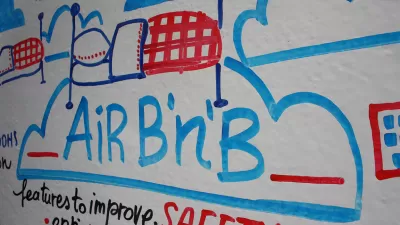The San Francisco Chronicle published a sweeping portrait of Airbnb's operations within the city of San Francisco—from previously unreleased data to personal stories of renters.
The bulk of the article details the findings of a first-of-its-kind data analysis of Airbnb operations, which is typically protective of data that tells the story of how and when its services are uses. "Although the company refuses to release numbers, a data analysis commissioned by The Chronicle found almost 5,000 San Francisco homes, apartments, and private or shared rooms for rent via Airbnb. Two-thirds were entire houses or apartments, showing how far Airbnb has come from its couch-surfer origins, and contradicting its portrayal as a service for people who rent out a spare room and interact with guests," according to the Chronicle's coverage.
Connotate Inc., a Web data harvesting firm, compiled the data from Airbnb’s website. Findings break down the total number of units are rented, what kinds of houses or apartments are rented, and how much they cost, among other metrics.
Gabriel Metcalf, executive director of SPUR, is quoted in the article, providing his take on the findings: "From a policy perspective, the real issue is whether there are a lot of units that have been removed from the housing market because of short-term rentals…It looks like that’s not a big number yet, but that’s what we need regulation to control so it doesn’t become big."
The Chronicle's broad coverage includes maps of the number of neighborhood rentals and average daily prices, as well as a suite of stories that dig deeper into the experience Airbnb.
FULL STORY: Window into Airbnb’s hidden impact on S.F.

Alabama: Trump Terminates Settlements for Black Communities Harmed By Raw Sewage
Trump deemed the landmark civil rights agreement “illegal DEI and environmental justice policy.”

Planetizen Federal Action Tracker
A weekly monitor of how Trump’s orders and actions are impacting planners and planning in America.

The 120 Year Old Tiny Home Villages That Sheltered San Francisco’s Earthquake Refugees
More than a century ago, San Francisco mobilized to house thousands of residents displaced by the 1906 earthquake. Could their strategy offer a model for the present?

Indy Neighborhood Group Builds Temporary Multi-Use Path
Community members, aided in part by funding from the city, repurposed a vehicle lane to create a protected bike and pedestrian path for the summer season.

Congestion Pricing Drops Holland Tunnel Delays by 65 Percent
New York City’s contentious tolling program has yielded improved traffic and roughly $100 million in revenue for the MTA.

In Both Crashes and Crime, Public Transportation is Far Safer than Driving
Contrary to popular assumptions, public transportation has far lower crash and crime rates than automobile travel. For safer communities, improve and encourage transit travel.
Urban Design for Planners 1: Software Tools
This six-course series explores essential urban design concepts using open source software and equips planners with the tools they need to participate fully in the urban design process.
Planning for Universal Design
Learn the tools for implementing Universal Design in planning regulations.
Clanton & Associates, Inc.
Jessamine County Fiscal Court
Institute for Housing and Urban Development Studies (IHS)
City of Grandview
Harvard GSD Executive Education
Toledo-Lucas County Plan Commissions
Salt Lake City
NYU Wagner Graduate School of Public Service



























